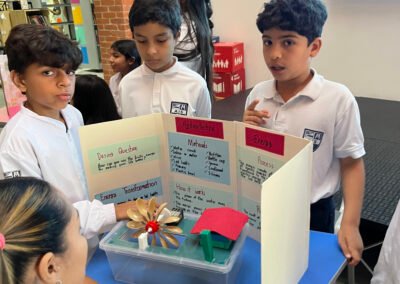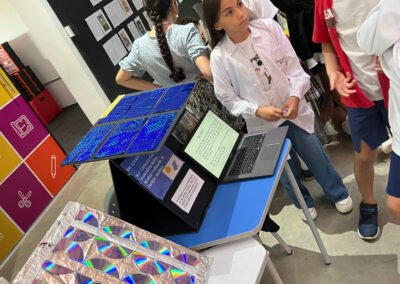ENERGY SOLUTIONS FOR A BETTER TOMORROW 4th GRADE (PBL UNIT 3 2024 / 2025)
Overview:
Students presented their prototypes during an Exhibition Day held at school. Parents did not attend; it was an internal showcase for students and teachers.
Driving Question:
¿How can we use energy transfer to design a sustainable solution for a local or global energy challenge?
Purpose of the Project:
Students will explore how energy is transferred and applied to solve a real-world problem that they can perceive and relate to. This project focuses on designing devices to address energy-related challenges specific to Barranquilla, Colombia, or global issues.
Objectives of the Project:
Challenges Adressed
- Local (Barranquilla/Atlántico): How can we help families in Barranquilla use solar energy to cool their homes and reduce their energy costs?
- National (Colombia): How can we design energy-efficient devices to help rural Colombian communities without reliable electricity access?
- Global: How can we design devices that reduce energy waste and promote renewable energy use worldwide?
Final Product
Students designed devices such as:
- Solar ovens.
- Small solar panels to power fans or motorized devices.
- Passive solar water heaters.
- Solar-powered lamps using LEDs and rechargeable batteries.
- Shade structures that reduce heat transfer while allowing light to pass through.
Skills Developed
- Scientific Inquiry: Making observations, collecting data, and analyzing energy transfer processes.
- Engineering Design: Applying ideas to solve real-world problems, designing, testing, and refining prototypes.
- Critical Thinking: Predicting outcomes, solving challenges, and evaluating device effectiveness.
- Collaboration and Communication: Working in teams to create solutions and presenting findings effectively.
Guiding Questions
- How is the energy transformed to be used by the family for their daily tasks?
- What challenges do you see in using renewable energy sources?
- How can energy transformations be used to solve your chosen problem?
- How can we ensure our solutions are sustainable?
- What materials or components would you need to make your solution work?
- How does your energy transfer system work?
Project Development Process
Workshops:
- Students worked at the Fab Lab with Mr. Boris using Tinker Cat and creating mood boards.
- Students researched energy sources and transformations, brainstormed solutions, and designed circuits in Tinkercad to demonstrate how energy can be transformed to perform a specific task.
- Activity: Students designed a simple circuit in Tinkercad to demonstrate how energy can be transformed to perform a specific task (e.g., lighting an LED, or powering a motor).
Entry Event: Talk by Oscar Tom, expert in solar panels.
Design Process: Brainstorm, Design, Investigate, Build, Test, Modify.
Duration of the project
The project was developed during Unit 3, with an approximate duration of 8 weeks.
Highlights:















About Us
Our Purpose
IDEA Model
Spaces
Our Team
Programs
Students
Clubs
Events & Activities
Projects
Spark
Services
Additional information
Contact
News
© 2024 AIS Innovation Center by Altamira International School. All Rights Reseved.